October 31, 2008
Air Date: October 31, 2008
FULL SHOW
SEGMENTS
A Push to Weaken Pollution Standards for Power Plants
View the page for this story
The Environmental Protection Agency is proposing to change the way pollution from coal-fired power plants is measured. Eric Schaeffer is a former EPA insider who now heads the Environmental Integrity Project. He tells host Bruce Gellerman the change will result in a large increase in the amount of sulfur dioxide and other pollutants emitted each year. (06:30)
Economics of Nature
View the page for this story
It’s difficult to put a price on the value of nature. But Deutsche Bank ecnomist Pavan Sukhdev has done just that. Pavan tells host Bruce Gellerman that he quantified the benefits of forests – looking at food, fuel, clean air and other so-called services -- and we’re paying a hefty cost for deforestation. (05:00)
People Power
View the page for this story
One city’s plan to get fuel from human refuse. Sandy Larson reports. (02:00)
Skin Color and Vitamin D
/ Ashley AhearnView the page for this story
Some 70 percent of Americans are vitamin D deficient. That’s according to the Centers for Disease Control. People get vitamin D from sunshine but those with darker skin need more sun than others. African Americans are more likely to have insufficient amounts of vitamin D than whites, and, as Ashley Ahearn reports, that makes them more likely to get certain types of diseases like cancer and diabetes. (07:00)
Geothermal Energy Heats Up
View the page for this story
The United States currently produces more geothermal energy than any other country in the world. Now, the Department of Interior wants to increase that ten- fold by making 190 million acres of public land available for geothermal exploration. Host Bruce Gellerman reports. (05:30)
The Language of Landscape
View the page for this story
Living on Earth continues its series exploring features of the American landscape. It’s based on the book “Home Ground: Language for an American Landscape,” edited by Barry Lopez and Debra Gwartney. This week, John Daniel explains the term “stratovolcano.” ()
Peddling Pedal Power to Congress
View the page for this story
A last-minute addition to the bailout bill is good news for bike commuters. The Bike Commuter Act makes cyclists eligible for up to $20 per month in tax credit for commuting-related expenses. Living on Earth host Bruce Gellerman talks with Congressman Earl Blumenauer, the original sponsor of the bill, about why he voted for the bike commuter bill before he voted against it. (04:00)
Scooter Love
/ Prachi Patel-PreddView the page for this story
Spectrum Radio’s Prachi Patel-Predd enjoys zipping around town on her shiny yellow scooter. It’s hip, it’s fast, it doesn’t use a lot of gas, and it’s better for the environment than cars. . .or is it? (04:00)
Alone in the Wilderness
View the page for this story
Bob Kull lived on an island in Patagonia without seeing another human being for an entire year. He wrote a book about his experience called “Solitude: Seeking Wisdom in Extremes” and tells host Bruce Gellerman why he chose isolation. (08:35)
Show Credits and Funders
Show Transcript
Host: Bruce Gellerman
Guests: Ray Brady, Michael Fehler, Bob Kull, Eric Schaeffer, Paven Sukhdev
Reporters: Ashley Ahearn, Prachi Patel-Predd
[THEME]
GELLERMAN: From Public Radio International, this is Living on Earth.
[THEME]
GELLERMAN: I'm Bruce Gellerman.
The Bush administration proposes new rules to measure power plant pollution. Critics say the changes would be a bad deal for public health, and cleaning the plants would be cheaper.
SCHAEFFER: The bottom line is – a large plant can cost the public about 700 million dollars a year. Asking them to spend 10 or 15 million dollars to put on a scrubber – that sounds like a bargain to me.
GELLERMAN: And, a sweet new deal for sweaty commuters…pedaling to work on two wheels gets a tax break:
BLUMENAUER: It’s much less expensive than driving a car – but it’s not free. Bicycles cost money – there’s bicycle maintenance….all of these would be eligible expenses that the employer could offset with no tax consequence to the bike commuter.
These stories and more this week on Living on Earth. Stick around!
ANNOUNCER: Support for Living on Earth comes from the National Science Foundation and Stonyfield Farm.
A Push to Weaken Pollution Standards for Power Plants
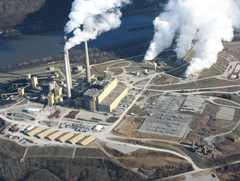
A coal-fired power plant in Kentucky. (Courtesy of the EPA)
[THEME]
GELLERMAN: From the Jennifer and Ted Stanley Studios in Somerville, Massachusetts, this is Living on Earth. I’m Bruce Gellerman, in for Steve Curwood.
The Bush administration is set to propose new rules for old power plants that burn coal. The rules are intended to streamline operations, but critics charge they violate the Clean Air Act. One of the leading critics is Eric Schaeffer. Six years ago Schaeffer was the official at the EPA in charge of enforcing federal environmental laws, but he quit, protesting that the Bush Administration was preventing him from doing his job. Now Schaeffer is the head of an EPA watchdog group, the Environmental Integrity Project.
SCHAEFFER: What the administration wants to do now is basically rewrite the law, change the law, here at the last minute. And they would do that by changing the definition of pollution increase. And the long and the short of it is this change would allow a power plant to increase their emissions by thousands of tons a year without having to get permits and without having to put on pollution controls.
GELLERMAN: Now as I understand it, what they’re proposing is they want to – they want to say that if a power plant updates or makes a major modification, they count their pollution not over the course of a year but over an hour.
SCHAEFFER: Yeah. And here’s why that matters. Let’s say I have a car, and that I drive 50 miles an hour and that’s my normal rate of speed. But I’m, of course, only using it a few hours a day. Let’s say I take the same car and suddenly I’m driving it all the time. Well I’m going to burn a lot more gasoline, and, of course, I’m going to generate more emissions. What the administration basically wants to do is let you take that car and instead of driving it a few hours a day, drive it all the time. So if you’re tooling along at 50 miles an hour, they would say well you’re still at 50 miles an hour, even though you’re driving a lot more, we’re going to pretend those extra emissions don’t exist.
GELLERMAN: So if this proposed rule change did go into effect, how much extra pollution do you think would be emitted?
SCHAEFFER: Some plants could double their emissions under this new rule. So if you’re a plant that’s got thirty, forty thousand tons of sulfur dioxide a year now, you could go to seventy or eighty thousand tons. It’ll vary by region, because some states have their own rules that are pretty strict. One thing that’s hard to grasp is, these are the oldest, dirtiest plants. Many of them have never had the most basic kind of pollution control equipment installed, okay – they’re the so-called grandfathered plants. And they’ve been operating without scrubbers, which have been required for new plants for thirty, forty years. So it really matters when these oldest and dirtiest plants get to suddenly double their operating time and just thumb their nose at the law and say, “Ha ha, you can’t catch me because even though my emissions have doubled, my hourly emissions are somehow bumping along at the same rate.” And that’s what this rule would do.
GELLERMAN: I was looking at the cost of scrubbers and I didn’t realize they cost 300, 400 million dollars per plant.
SCHAEFFER: Yeah, that’s a scrubber for a large base-load plant. But, again, you know those costs can sound scary. What happens though, is the company will take that investment in pollution control technology, and they’ll of course borrow the money at very low interest rates, and they’ll roll that cost over about a twenty or thirty year period. So the true cost of putting a scrubber on is, I don’t know, ten or fifteen million dollars a year if we look at the annualized costs – it’s actually much lower. The other thing to remember is that, according the White House, a ton of sulfur dioxide costs the public health about $7,000 a year, each ton. Some of these plants put out 100,000 tons of year of sulfur dioxide. So you’re looking at a public health cost of $700,000,000 – a year. And that’s because the pollution from these plants creates fine particles that get into your lungs and trigger lung diseases and heart diseases and cause premature death. And so the bottom line is a large plant can cost the public about $700,000,000 a year. Asking them to spend ten or fifteen million dollars a year to put on a scrubber – that seems like a bargain to me. It does cost money to do the right thing. It’s not free. And when it’s not required, it’s not the kind of thing that power plants are going to do voluntarily. I wish I could tell you – on a lot of environmental debates there really are two sides, and while I may passionately argue one position, I can kind of understand the advocates on the other side and you can hope to reach some kind of compromise. I just don’t see that here. I don’t see that here. This is nothing but a power play at the last minute, with really no public policy argument behind it. Something that’s gonna increase pollution and make people sicker.
GELLERMAN: You still have plenty of friends in the EPA, right?
SCHAEFFER: Oh yeah, sure I do. I just talked to one this morning, in fact.
GELLERMAN: Yeah? What do they say about this?
SCHAEFFER: They’re disgusted, really disgusted. This rule was opposed, I think it’s fair to say, by just about every career civil servant at EPA. They know it’s environmentally outrageous and legally very fishy, and likely to be withdrawn by the next administration.

A coal-fired power plant in Kentucky. (Courtesy of the EPA)
GELLERMAN: So you mean like “Hasta la vista, baby.”
SCHAEFFER: [laughs] yeah. That’s right. This won’t be the only rule they try to get away with. I expect there will be kind of a midnight run of bad regulations that are on the industry’s wish list, and they’ll be throwing more of these over the fence in their last days. But what a way to leave EPA, by parking these, you know, these really bad environmental rules on the doorstep of the next administration. What a, what a legacy.
GELLERMAN: Eric Schaeffer resigned as the head of regulatory enforcement at the EPA in 2002. He is now the head of the Environmental Integrity Project.
[MUSIC: Bombay Dub Orchestra “Map Of Dusk” from 3 Cities (Six Degrees 2008)]
Related links:
- EPA on the Clean Air Act
- Sierra Club on the Clean Air Act
- Environmental Integrity Project on Clean Air Act
Economics of Nature
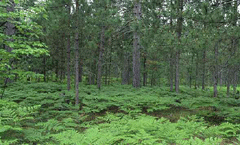
Forests provide clean water for drinking and irrigation-- currently a free commodity. (Courtesy of US Fish and Wildlife Service)
GELLERMAN: How much is a mountain vista worth to you? How about the value of waves breaking on the shore? Pavan Sukhdev is putting a price tag on the wonders of nature for The European Commission and the German government. They wanted to find out the Economics of Ecosystems and Biodiversity…and called on Sukhdev to quantify them. Pavan Sukhdev is a Managing Director at Deutsche Bank. His first report deals with the cost of deforestation, costs he says dwarf the current global financial meltdown.
SUKHDEV: We found that the rate of the loss of the forest, and therefore the rate of loss of the services that forests deliver to people - that’s food, fiber, fuel, flood prevention, drought control, ecotourism, bio prospecting, etc., etc. - that came to something like two to four-and-a-half trillion dollars per year. Compare to that my estimates of the financial capital loss to the Wall Street banks and to the city banks here in London is of the order of one to one and a half trillion. So, you know – take your pick. Another way of looking at it is that if we let this carry on, then by 2050, every year we would be losing seven percent of GDP in terms of public welfare from these forests. And, of course, there will be more to come, because we are now looking at other biomes like the coastal mangroves, which we did not consider, and coral reefs, which we have not yet studied in detail, although we are collecting good information on that.

Coral ecosystems-- the next economic frontier. (Courtesy of NOAA)
SUKHDEV: Yeah – that’s a very good question. Now take a couple of examples. Today we have got cures for Alzheimer’s disease and for cancer being explored respectively from a worm that is found on a coral reef and from a creature that lives on coral reefs. Now, we know what kind of potential benefits that would be. We know the nature of these markets. We also know the budget that pharmaceutical concerns spend on bioprospecting. So these two enable us to work out - alright, so how much of that budget would be spent going forward on coral reefs and how much of the potential income of those companies would be as a result out of new cures found – just imagine the scale and size of a cancer cure and a cure for Alzheimer’s disease. It’s huge, economically.
GELLERMAN: You know when bankers traditionally think of green, they think of, well, money, and I was looking at your background – you’re an economist. A managing director, the head of one of the world’s biggest banks, Deutsche Bank, and yet, I guess, you’re a tree hugger?
SUKHDEV: [LAUGHS] I think that’s a bit extreme, but, I’m certainly – you know, I sometimes get asked, “How the hell do you reconcile this? You know, how do you sort of reconcile the fact that you have these environmental leanings and at the same time you’re financial markets managing director? Well, are you a capitalist or are you not?” And my response usually is, “Yup, I’m a total capitalist.” But what I really mean by saying I’m a total capitalist is that I believe in all forms of capital. I believe in financial capital, I believe in human capital, and I believe in natural capital. I don’t discriminate one from the other. You’d be amused to hear there’s a friend of mine in Singapore, many, many years ago, fifteen years ago, asked me this very simple question “Look, you’re a banker and all that. Tell me, why are some things worth money and some things not? How come that I can watch a sunset for free and how come I have to pay for a movie?” And then I thought and thought about that and I said, “This is a deep and fundamental point. There is this aspect of ignoring value when it doesn’t transact in markets.” And that’s the key, because we have psychologically convinced ourselves that what’s valuable is what transacts for money, but very often what’s valuable is other things like friendship and law and order and education and enjoyment of nature and so on. We need to be a bit more holistic in the way we think about these things.
GELLERMAN: Well, I want you to put on your banker’s hat again, and talk money. What is it going to cost to conserve, to save this, you know, natural wealth?

Forests provide clean water for drinking and irrigation—currently a free commodity. (Courtesy of US Fish and Wildlife Service)
GELLERMAN: Well, Mr. Sukhdev, thank you very much. I appreciate it.
SUKHDEV: Thank you very much indeed. It’s been great talking to you.
GELLERMAN: Pavan Sukhdev is a managing director at Deutsche Bank and head of the project: The Economics of Ecosystems and Biodiversity.
[MUSIC: Easy All-Stars “Great Gig In The Sky” from Dub Side Of The Moon (Easy Star Records 2003)]
GELLERMAN: Just ahead, vitamin D…D for deficient. Keep listening to Living on Earth!
Related links:
- Deutsche Bank
- For more Information on Ecosystem Services
People Power
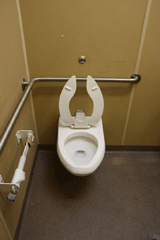
San Antonio’s waste-to-fuel project gives new meaning to the term ‘natural gas.’
GELLERMAN: It’s Living on Earth – I’m Bruce Gellerman. Coming up, “Drill baby drill” – but not for gas or oil. First, this note on emerging science from Sandra Larson.
[SCIENCE NOTE THEME]
LARSON: “Waste not, want not.” The water department of San Antonio, Texas certainly takes that adage seriously, and keeps finding creative ways to reuse what residents flush down their toilets.
San Antonio Water System, or SAWS, already recycles liquid from sewage to use in landscaping and manufacturing; some of the solids go into compost. And now they’re going to reap other benefits from the sewage by harvesting the methane gas generated by solid waste, and selling it as fuel.
SAWS recently signed a deal with Ameresco, a Massachusetts-based energy services company. Ameresco will build and operate a new facility in San Antonio to capture some million-and-a-half cubic feet of methane a day. They’ll sell the gas to power companies, and pay a royalty to SAWS.
Methane from the city’s sewage is normally burned. Now, instead of going up in smoke, the gas is expected to earn about 250,000 dollars a year for SAWS. That means better air quality, lower operating costs, and lower water bills for ratepayers.
Other communities already capture methane from animal waste or landfills; some even use human waste to power sewage treatment plants. But San Antonio will be the first US city to convert its sewage to methane on a large scale and sell it as energy. When the facility opens, San Antonio will be recycling more than 90 percent of its human waste – giving a new meaning to people power.
That’s this week’s note on emerging science. I’m Sandra Larson.
[SCIENCE NOTE THEME]
Related link:
San Antonio Water System
Skin Color and Vitamin D
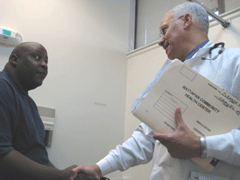
Samuel Clemens talks with his doctor, Douglass Bibuld, about vitamin D at a recent check up at Mattapan Community Heatlh Center in Boston. (Photo: Ashley Ahearn)
GELLERMAN: There are a few things you should know about Vitamin D. First - It’s not a vitamin: in the body, it acts like a hormone, where it plays a critical role in making bones strong, beefing up the immune system, and regulating the growth of cells. Not having enough Vitamin D may increase your chances of getting certain cancers, osteoporosis, diabetes, even Parkinson’s Disease - and the Centers for Disease Control says 70 percent of us don’t get enough. Vitamin D is called ”the Sunshine Vitamin” because without the sun’s rays, our skin can’t make it. And the darker your skin, the harder it is to get the D you need. Which is why African Americans are twice as likely to have insufficient amounts of vitamin D than whites. This much we know. But, as Living on Earth’s Ashley Ahearn reports, there's still a lot left to learn about Vitamin D.
[DOCTORS OFFICE SOUNDS]
BIBULD: Say Aaaahh…
CLEMENS: Aaaahhh.
BIBULD: Deep breath in and out…
[BREATHING SOUNDS]
AHEARN: It’s a routine check up at Mattapan Community Health Center in Boston.
[BREATHING IN AND OUT]
AHEARN: Samuel Clemens and his doctor, Douglass Bibuld talk about allergies, sleeping problems, a recent asthma attack – and then Dr. Bibuld turns to the subject of his patient’s vitamin D levels.
BIBULD: Below 30 is considered insufficient, below 20 is considered deficient and Mr. Clemens was at eight.
AHEARN: That’s eight nanograms per milliliter of blood. Dr. Bibuld wants to get Clemens level up to 40, so he has him taking over 7,000 units of Vitamin D per day. That’s 17 times more than the government recommends for adults.
The majority of patients at Mattapan Community Health Center are African American, and 90 percent of the patients here are vitamin D deficient. In response to emerging research the clinic routinely tests patients’ vitamin D levels. Dr. Bibuld tells Clemens, who is African American, why he needs to supplement his vitamin D intake.
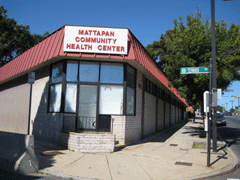
The Mattapan Community Health Center serves 7,000 patients, the majority are African American and 90 percent of patients are vitamin D deficient. (Photo: Ashley Ahearn)
CLEMENS: Oh okay, I never heard it put that way, okay.
AHEARN: It’s thought that people evolving in equatorial regions - where the sun’s UV rays are the strongest - developed more melanin in their skin for protection.
Dr. Michael Holick is an expert on vitamin D at the Boston University School of Medicine. He says in places where the sun’s rays are weaker, people with more melanin are at a disadvantage when it comes to getting the vitamin D they need.
HOLICK: It’s like wearing a sunscreen with a sun protection factor of 15 which reduces your ability to make vitamin D in your skin by 99 percent, and that’s why most African Americans are at extremely high risk of vitamin D deficiency.
AHEARN: Holick believes vitamin D deficiency may be associated with the higher rate of cancer among African Americans.
HOLICK: Vitamin D helps control cell growth and that’s why we think it will reduce risk of many deadly cancers like prostate, breast, and colon by as much as 50 percent - and African Americans are at much higher risk of having these cancers and we believe that it’s in part due to their vitamin D deficiency.
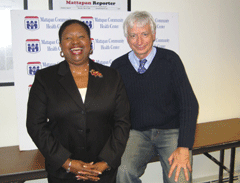
Dr. Azzie Young, president of Mattapan Community Health Center, approached Dr. Michael Holick, an expert on Vitamin D at the Boston University School of Medicine, when she learned about the health effects of Vitamin D deficiency, especially among African Americans.(Photo: Ashley Ahearn)
Holick’s research shows that if you’re obese you’re twice as likely to be deficient in Vitamin D, although researchers don’t agree on the mechanism behind this relationship.
We’re just beginning to understand the science of vitamin D and the research is sparking some controversy.
Many doctors say light-skinned people need 15 minutes of sun each day to get their vitamin D, but dermatologists are concerned that any exposure to sunlight may lead to skin cancer. And Dr. Holick has come under fire for getting five percent of his research funding from a group that represents the indoor tanning industry.
There’s not a clear consensus on a recommended dose of vitamin D either. Some experts say that adults of all skin colors should take 1,000 units of vitamin D per day and that some individuals may need more. But the government recommends much less; 200 units of vitamin D per day for newborns to teenagers, 400 for adults, and 600 for people over 70.
Dr. Mary Frances Picciano is a senior research scientist in the Office of Dietary Supplements at the National Institutes of Health.
PICCIANO: We don’t have a good history of people taking high doses for long periods of time, so I am very fearful of toxicity with all this enthusiasm, quite frankly.
AHEARN: The National Academy of Sciences plans to reexamine recommended Vitamin D levels by 2010.
[WAITING ROOM SOUNDS FADE UP, CARRIBEAN FRENCH SPOKEN]
AHEARN: Back at Mattapan Community Health Center, a group of Carribean immigrants sits in the waiting room. By the end of their first winter in Boston, they’re just as deficient in Vitamin D as the patients who have lived here all their lives. Dr. Azzie Young is the president of Mattapan Community Health Center.
YOUNG: Mattapan has some of the most serious health problems in Boston, and once we learned that vitamin D deficiency is a major disease for our community we were very concerned about getting everybody on board, making sure that all of our patients have a sufficient level of vitamin D.
AHEARN: But it’s not just the patients that are concerned about vitamin D. As an African American, it’s on Dr. Young’s mind as well.
YOUNG: My doctor said to me that we should take your vitamin D level because African Americans are at high risk for being vitamin D deficient. I had a dismal 12 - yeah, my level was 12 nanograms per milliliter.

Samuel Clemens talks with his doctor, Douglass Bibuld, about vitamin D at a recent check up at Mattapan Community Heatlh Center in Boston. (Photo: Ashley Ahearn)
YOUNG: I’m over 40.
AHEARN: And do you feel different?
YOUNG: I feel wonderful. I can bounce out of a chair. I can walk without any problems and also I sleep better. It has made a big difference in my life and I’ve been spreading the word in any kind of way we can.
AHEARN: Dr. Young is working to raise awareness about vitamin D deficiency nation-wide. And research continues on the specific health benefits of vitamin D, but with more evidence that vitamin D deficiency may be associated with diseases like cancer, type II diabetes and Parkinson’s, it’s clear that people need to take Vitamin D supplements. Just how much we need to take is an open research question.
[WAITING ROOM SOUNDS]
For Living on Earth, I’m Ashley Ahearn in Mattapan, Massachusetts.
[MUSIC: David Byrne/Brian Eno “I Feel My Stuff: from Everything That Happens Will Happen Today (Todomundo Records 2008)]
Geothermal Energy Heats Up
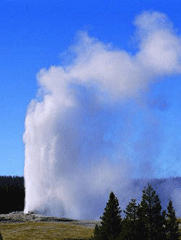
Federal officials won’t tap Old Faithful for geothermal energy, but they do hope to capitalize on other geysers in the geologically active West. (Courtesy of Idaho National Laboratory)
GELLERMAN: The answer to our energy needs could be right under our noses, or more accurately, right under our feet: it’s geothermal energy, and advocates say by mining into the earth’s heat we can release a virtually inexhaustible supply of clean power, which requires no fossil fuels, produces little greenhouse gases, and can generate electricity about as cheaply as burning coal. It’s simple - drill a hole in a hot spot, and tap the heated water and steam that comes out.
Geothermal is a proven technology. There are geopower plants around the world - one in Italy has been producing energy for over a hundred years - but the United States is, by far, the world geothermal leader. We get as much electricity from geothermal energy as solar and wind combined. And the Department of the Interior has big plans for geothermal. It just announced it’s opening up 190 million acres of federal land in 12 western states to geothermal development. That’s an area twice the size of California.
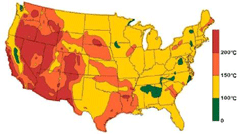
The best geothermal hot spots are located west of the Rocky Mountains.
BRADY: Right now we have just over 1,200 megawatts of geothermal capacity. That’s enough electricity to power approximately 1.2 million homes. We could potentially increase that production by fivefold by the year 2015. By 2025 that capacity could potentially power twelve million homes.
GELLERMAN: The plan permits private energy companies to bid on public land. Half the revenue from the leases would go to the state, a quarter to the federal government and a quarter to local counties. We’re talking big bucks. Just three geothermal leases recently went for $52 million. Of course being public land, the 192 million acres include some of the most environmentally sensitive open spaces in the country. Ray Brady says the Department of the Interior has come up with a programmatic environmental impact statement that puts many of the areas off limits to geothermal exploitation.
BRADY: And this would include all wilderness areas, wilderness study areas, sensitive resource lands, areas that are designated as national parks, national monuments, national conservation areas, etc. So there is a lot of the very sensitive resource lands that are not available for geothermal leasing.

Ray Brady is Energy Team Leader for the Bureau of Land Management.
BRADY: We would not. No.
GELLERMAN: Mining all that heat energy in the earth is one thing, turning it into electricity is another. Ray Brady acknowledges geothermal plants will have environmental impacts.
BRADY: There will be surface facilities. There will be wells and well pads. There will be pipelines that transmit the hot fluids and steam to the generating facility. There will be the plant facility itself. There will be access roads. Try to keep the footprint to the minimum possible - however, there will be surface disturbance, yes.
GELLERMAN: And there will need to be new transmission lines to get the electricity to market. Thousands of miles of overhead lines are already being built in western states. But there are concerns about the environment under the ground as well. There are fears geothermal plants could trigger earthquakes.
BRADY: You know many of these geothermal resources are in geologically active areas. So there’s some likelihood that that might potentially occur, and that’s another one of the reasons that you are reinjecting fluids back into the ground to insure that you have a stable geologic environment.
GELLERMAN: Recirculating the water back into the ground also solves two other problems. Geothermal hot water can be highly acidic and slightly radioactive. But as ambitious as the federal government’s new190 million acre geothermal plan is, it pales in comparison to the potential promise of a new technology called Enhanced Geothermal Energy. Michael Fehler is a Senior Research Scientist at MIT and a corporate geothermal consultant.
FEHLER: The idea is to drill holes and make a manmade geothermal system. And so what we do is we drill a hole, and we use something called hydraulic fracturing to create a fracture system that water can flow through. And then we drill another well into that fracture system so now we have two wells that are drilled into a fracture system. We inject water into one of them, and it flows through the fractures, absorbs heat from the earth, and it comes up hot. And then we can take the heat from that water and convert it into energy.

Federal officials won’t tap Old Faithful for geothermal energy, but they do hope to capitalize on other geysers in the geologically active West.(Courtesy of Idaho National Laboratory)
FEHLER: The hope is that a given well pair – you need two, at least two wells – could last twenty to thirty years. When people look at how they might develop a field, they think of developing several well pairs over time so that as one well pair started phasing out, your power plant would still be usable, have a usable lifespan, and basically extend the life of your geothermal resource within the area. So, in that way you could go on probably several centuries in a given region.
GELLERMAN: Potentially, enhanced geothermal opens up the entire planet for energy production. MIT researchers estimate that the earth’s usable geothermal energy could supply the world’s needs for a quarter of a million years. Professor Fehler:
FEHLER: I don’t think geothermal can completely solve the energy problem, but I think it can contribute to the mix. And I’m hopeful that it will. Google is investing in geothermal now. So, you know, I think, you know we’re seeing not only government but entrepreneurs getting interested in this technology
GELLERMAN: Professor Fehler emphasizes enhanced geothermal is still just experimental. But stay tuned. It’s hot.
[MUSIC: Daniel Lanois "O Marie" from 'Acadie' (Daniellanois.com – 2005)]
Related link:
Department of the Interior
The Language of Landscape
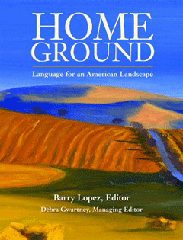
(Courtesy of Trinity University Press)
Among the earth’s geothermal sweet spots are areas where volcanic activity is high. They’re not places people ordinarily live - but awe-inspiring features of our planet - also featured in the book, “Home Ground, Language for an American Landscape.” It’s a compilation of geological terms edited by Barry Lopez and Debra Gwartney, and an occasional series on Living on Earth. Today, John Daniel’s definition of “Stratovolcano.”
DANIEL: Stratovolcano. Stratovolcanoes, also called composite or cone volcanoes, are known for their stature as mountains and for their variety of utterance. Venting at times pyroclastic – “fire-broken” – particulates, as Mount St. Helens did in 1980, and at other times exuding lava, a stratovolcano develops a layered composition as it grows. The steeply bedded ash and cinders of its pyroclastic explosions tend to give it a conical form, while its gentler expressions of lava provide structural stability. All the major Pacific Rim volcanoes are stratovolcanoes. By present measurements, it takes anywhere from roughly 20,000 years (St. Helens) to more than half a million years (Hood and Rainier) to build a stratovolcano of respectable size. Some erupt so exuberantly that they self-destruct. Mount Mazama, a 12,000-foot peak in the southern Oregon Cascades composed of several overlapping volcanoes, emptied its magma chamber and blew off its upper four thousand feet - 12 cubic miles of rock - in a single day some 6,800 years ago, collapsing into a caldera we call Crater Lake.
GELLERMAN: John Daniel lives and writes in the hills just outside of Eugene, Oregon. His definition of stratovolcano comes from the book "Home Ground: Language for an American Landscape," edited by Barry Lopez and Debra Gwartney.

(Courtesy of Trinity University Press)
GELLERMAN: You can hear Living on Earth anytime on our website, or get a download for your MP3 player. The address is loe.org. That's L-O-E dot O-R-G. There you’ll also find pictures and more information about our stories and show. We’d particularly like to hear from you now – because next time on our program, we’ll be featuring what you think the new president’s environmental priorities should be, and what the new administration should do about energy in its first 100 days.
Our email address is: comments@loe.org – that’s comments at l-o-e dot o-r-g - or you can call us: 1-800-218-99-88, or 1-800-218-9-9-8-8. Your ideas - next time on Living on Earth.
Coming up: how the chain gang can earn a tax credit. Keep listening to Living on Earth.
ANNOUNCER: Support for the Environmental Health Desk at Living on Earth comes from the Cedar Tree Foundation. Support also comes from the Richard and Rhoda Goldman fund for coverage of population and the environment. And from Gilman Ordway for coverage of conservation and environmental change. This is Living on Earth on PRI, Public Radio International.
Peddling Pedal Power to Congress
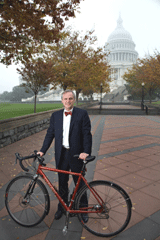
Congressman Earl Blumenauer, representing Oregon’s 3rd district.
GELLERMAN: It’s Living on Earth, I’m Bruce Gellerman.
Earl Blumenauer has spent the last seven years in Congress peddling an idea whose time has finally come - a 20 dollar a month federal tax credit for commuters who bike to work. The Oregon democrat, founder of the Congressional Bike Caucus, saw his bike bill become law as part of the 700 billion dollar Wall Street bailout - but no thanks to the Oregon democrat. He voted against the bailout - and his own bill. Earl Blumenauer joins me by phone from Washington. Congressman – thank you!
BLUMENAUER: Absolutely my pleasure.
GELLERMAN: So how does it work? You bike to work and you get a savings on your tax?
BLUMENAUER: Well currently the tax code enables an employer to favor people who drive to work by giving them free parking, a value of over $2,400 a year. And it’s not a taxable benefit. You can get a transit pass and get over $100 a month tax free. But if you are burning calories instead of fossil fuel, that all comes out of your own pocket, and if your employer would give you some money to offset the costs, that would be taxable to you. We’ve changed the law, finally, so that the employer can give you $240 a year, tax free, to offset the real costs of bike commuting. It’s much less expensive than driving a car, but it’s not free. Bicycles cost money, there’s bicycle maintenance. Some people need shower facilities. Or, I’m from Portland, Oregon where it rains all the time, so we need rain gear. All of these would be eligible expenses that the employer could offset with no tax consequences to the bike commuter.
GELLERMAN: And it was your bill.
BLUMENAUER: It was indeed.
GELLERMAN: Now Congressman, you opposed the bailout bill, right?
BLUMENAUER: I did.
GELLERMAN: So you voted for the bicycle commuter tax credit before you voted against it.
BLUMENAUER: [Laughs] You could say that, yes. Each time that it passed the House – it actually passed the House five different times – it was part of important energy provisions that I’ve worked for, dealing, not just with bicycles, but with solar and wind energy, for instances. But they didn’t add to the deficit. They were paid for, as the term goes. This massive addition to the bailout bill added a hundred billion dollars to the deficit and frankly, I didn’t feel comfortable with the bailout provisions, because as it was being explained to Congress and the American public, it was too much for the wrong people to do the wrong things. So I ended up voting against a bill that contained some things that I have fought hard for.
GELLERMAN: How many members of the Congressional Bike Caucus?
BLUMENAUER: Well we have over 200 members now. It’s “bike-partisan” I will say. It has both Republican and Democratic members. And we’re promoting sound policies for improving cycling.
GELLERMAN: Boy, if you put a Democrat and a Republican on a bike built for two it would be one of the few times they’d be going in the same direction.

Congressman Earl Blumenauer represents Oregon’s 3rd district.
GELLERMAN: Boy, it gives new meaning to the idea of peddling power on Capitol Hill.
BLUMENAUER: [Laughs] Absolutely.
GELLERMAN: Oregon Democrat Earl Blumenauer is the founder of the Congressional Bike Caucus and the principal sponsor of the bicycle commuter tax credit.
Related links:
- Congressman Earl Blumenauer’s website
- To learn more about the Bicycle Commuter Act, check out the American League of Cyclists’ website
Scooter Love
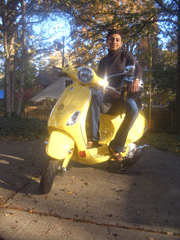
Reporter Prachi Patel-Predd. (Photo: Joel Predd.)
GELLERMAN: Well, maybe even with a tax break, bikes aren’t your ride. Maybe scooters are more your speed. In Europe, 30 million people use scooters. In the U.S. it’s just one million…including Spectrum Radio’s Prachi Patel-Predd.
[SCOOTER SOUNDS]
PATEL-PREDD: My brand new, bright yellow scooter arrived a few months ago. Since then, doing groceries or going to the post office have stopped feeling like chores. I can’t wait to strap on my helmet and scoot around town running errands. At the local library one afternoon, a short, middle-aged woman approached me soon after I put my scooter on its stand.
WOMAN: It’s very cute.
PATEL-PREDD: The woman didn’t want to be named. But I asked her if she’d consider buying a scooter.
WOMAN: I probably wouldn’t because I commute quite a ways to work so all I would do was around town which I don’t do that much anyway but otherwise I would - If I worked in town I would.
PATEL-PREDD: Luckily, I work from home and most of my driving is on city streets. Speed limits around here are between 25 to 40 miles per hour. So I’m not slowing traffic down. That’s not to say that my scooter can’t go fast. Its 150 cubic centimeter engine packs quite a punch, and could take me up to 60 miles per hour.
But I didn’t buy the scooter for speed. I bought it because it was cheaper than a car, more fun, and much easier to park around town. And I wanted to reduce my carbon footprint. My scooter gives me about 65 miles per gallon. That’s three times the fuel efficiency of the average U.S. car. Roughly, that means three-times fewer carbon dioxide emissions. But what about other emissions? I decided to investigate.
[PHONE RINGING]
SIMON: Hi, this is Karl Simon.
PATEL-PREDD: Karl Simon is with the Environmental Protection Agency’s Office of Transportation and Air Quality. He told me that the EPA regulates carbon monoxide and hydrocarbon emissions for small scooters like mine. And surprisingly, scooters are big emitters of those pollutants.
SIMON: So if you compare the small scooter, emissions would be higher than a comparable car if you’re driving the same distance down the road.
PATEL-PREDD: Scooters have higher emissions than cars? They’ve certainly come a long way, though. Older scooters have two-stroke engines, like the ones found in lawnmowers and chainsaws. Those machines belch smoke because they burn a small amount of oil along with fuel. Most new scooters have four-stroke engines, which are much cleaner. But cars have more room for emissions control technologies, says Simon.
SIMON: You know, you pop the hood of your car and look at your engine and computer controls and the catalytic converter that’s on the car you get a significant amount of controls there.
PATEL-PREDD: My scooter meets European emission limits, which are stricter than EPA standards. So, just based on those limits, my scooter emits more hydrocarbons but less carbon monoxide than new American cars. That’s a relief! I can calculate exactly how much CO2 and carbon monoxide I’m saving by switching to a scooter. And there are other pluses to riding a two-wheeler.
CJ: …easy on gas, most likely more easy on the pocket, adventurous fun.
PATEL-PREDD: Back at the library, a young college student agrees that two wheels are the way to go.
CJ: Nowadays I really don’t want a car, especially my own, maintenance is high and gas is high. I’d want something simple like a bike or a scooter.
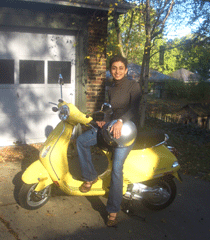
Prachi Patel-Predd. (Photo: Joel Predd.)
[SCOOTER SOUNDS]
GELLERMAN: Puttering into the sunset is Prachi Patel-Predd. Her report comes to us courtesy of Spectrum Radio, the broadcast edition of IEEE Spectrum, the magazine of technology insiders.
[MUSIC: Various Artists “When You Were The Girl On The Scooter” from Dance Band Rarities (Memoir Records 2001)]
Alone in the Wilderness
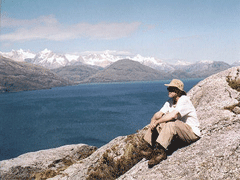
Kull sitting on a rock on a rare sunny day, a year after his year of solitude was complete. (Photo: Patti Kuchinsky)
GELLERMAN: Have you ever been alone…I mean, really alone…for a long time? Well, Robert Kull has. In 2001, Kull set up camp on a remote island in the Patagonia wilderness, and he lived there, alone, for a year. Kull recounts his journey in his new book: “Solitude—Seeking Wisdom in Extremes” - and Robert Kull, welcome back to civilization, and to Living on Earth.
KULL: Thanks for inviting me, Bruce. It’s good to be here.
GELLERMAN: Gosh, a year is an awfully long time to live by yourself in the wilderness. Why Patagonia?
KULL: There’s nobody there. I considered the coast of British Columbia, but as I talked to people, I recognized there are a lot of boats and airplanes and kayakers and logging and mining. I’d come up the coast of Southern Chile several years before, there’s a ferry that plies the coast, and completely fell in love with it. It’s just amazing down there, it’s incredibly beautiful and on this ferry for three and a half days we went by one tiny little town. There were no airplanes, no other boats, no mining, no logging and I thought this is a place - this is remote enough that I could literally be here for a year and not see anyone.
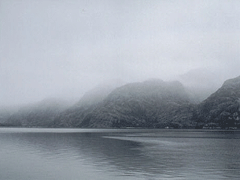
The pacific coast of southern Chile. (Photo: Bob Kull)
KULL: Oh yeah. No, absolutely. I’m not arguing to live in solitude forever. But it seems to me that we’ve gone overboard in some sense. That some psychologists argue that the only way to be human is through relationships with other people. So I find that to be fully human is not only about relationship with other people, but it’s about coming into a deeper relationship with ourselves and with the nonhuman world and with this mysterious presence. And for me, when I come into a deeper relationship with myself in solitude, it opens me more to being able to be in more profound and intimate relationship with other people when I come back.
GELLERMAN: But you weren’t alone. You had a cat.
KULL: Yeah, I did have a cat. It wasn’t my plan. I didn’t want to take a pet, that’s – it changes the dynamic to have a pet, and it wasn’t my intention at all. But the government officials in southern Chile told me that there was a lot of red tide there, and if I wanted to eat any shellfish, which I intended to, I needed to have a way of testing to see if they were poisonous. And I wouldn’t have access to the government reports, so what local people do is they use a cat as a guinea pig. They feed suspect shellfish to a cat, and if the cat dies, they don’t eat it themselves. But, of course, it didn’t work. We got very close, very quickly and instead of Cat testing shellfish for me, I was out catching fish for Cat.

Bob Kull’s cat, “Cat,” eating fish that he caught for him. (Photo: Bob Kull)
KULL: Oh yeah. Yeah, it was a high tech trip. It was very different from other retreats into solitude. Often I go with a canoe and a tent and a fishing rod sort of a thing. And this time, one thing led to another. It was a very harsh climate, so I was gonna need a fair amount of firewood, and I thought, well, I need a chain saw, and I needed an outboard because all the wood had to come in by boat. And so, once I took that, that led to a whole bunch of other stuff.
GELLERMAN: Well, you go on this journey and you’re living alone in Patagonia, and I’m wondering, given the harsh conditions, does suffering enter into this? Was it the goal?
KULL: Oh yeah. Oh yeah. Yeah, there was a lot of pain. One of the interesting things is, I’m a wuss. I’m a real – I don’t like pain. Some people – I know people that just suck it up and – but I’m full of – my journal was just so full of whining about “oh, it’s so hard and I hurt ...” I fell hard a few times, and I tore the rotator cuffs in both shoulders and that’s a very painful injury. And so there were months when I was just in a lot of pain, and I couldn’t stop working, I had to – for survival I had to keep working. And then, later on I – there was emotional pain because I started seeing things about myself that I didn’t really like. One of the challenges and opportunities of solitude is this need to face yourself, there are no easy escapes.
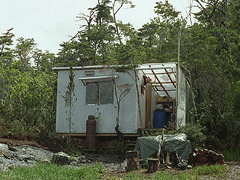
The cabin that Kull built on the island out of materials brought with him from the mainland. (Photo: Bob Kull)
GELLERMAN: Did you ever feel like you were going crazy?
KULL: Yeah. Yeah.
GELLERMAN: Did you go crazy?
KULL: I don’t know. [Laughs] I mean, who would notice? There’s that kind of feeling, you know.
[LAUGHING]
KULL: You have to be a little crazy to do something like this, right?
GELLERMAN: So your book – is about me reading it? Or is it about you writing it?
KULL: It’s about us journeying into solitude together. I didn’t want to just describe my own journey into solitude, but to invite readers to come there with me. And also to invite readers to reflect on their own lives wherever they’re living, because I don’t think it’s a particularly heroic thing to do, to go live alone in the wilderness for a year. I think that all our lives are heroic – if we live fully wherever we are, whether it’s raising kids or going to work. That’s an incredibly challenging process and it takes everything we’ve got. What we’re looking for we already have. I mean, this is the irony. You know, we keep looking for simple answers, we keep looking to spiritual teachers or psychologists - “well, just tell me what I have to do. Give me this 1, 2, 3 step to fix myself.” And I don’t think it works that way.
GELLERMAN: When you were out there on the coast on this lonely – well, alone – on this island, was there music in your mind?
KULL: Sometimes. Just short phrases. The Navajo beauty song came through my mind for a while, and Simon and Garfunkel “I am a rock, I am an island.” Especially when I was out in my boat on a calm day, standing in the front of the boat, just zooming through this unfolding universe, this expanding universe, on a glassy day.
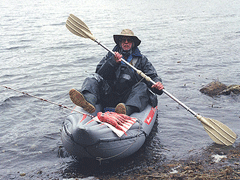
Kull in his Sevylor inflatable kayak. (Photo: Bob Kull)
GELLERMAN: Well, Robert Kull, I want to thank you very much. I really appreciate it.
KULL: It’s my pleasure. Thank you for inviting me on.
GELLERMAN: Robert Kull’s new book is called “Solitude: Seeking Wisdom in Extremes.”
[MUSIC: Simon & Garfunkel “I Am A Rock” from Live From New York City 1967 (Sony Records 2002; and Various Artists: “I Am A Rock” from A Bluegrass tribute To Simon And Garfunkel: Homeward Sound (CMH Records 2004)]
Related link:
For more on Bob Kull, click here
GELLERMAN: On the next Living on Earth - What do you think the new president’s environmental priorities should be? We want to know…so tell us:
What should the new administration do about energy and the environment in its first 100 days? Our email address is: comments@loe.org – or you can call us: 1-800-218-99-88. That’s Comments at L-O-E dot O-R-G – or 1-800-218-9-9-8-8. We’ll feature your ideas - next time on Living on Earth.
GELLERMAN: Living on Earth is produced by the World Media Foundation. Our crew includes Ashley Ahearn, Bobby Bascomb, Eileen Bolinsky, Ingrid Lobet, Helen Palmer, Mitra Taj and Jeff Young, with help from Sarah Calkins and Marilyn Govoni. Our interns are Sandra Larson and Jessie Martin. Jeff Turton is our technical director. Alison Lirish Dean composed our themes. Steve Curwood is our executive producer. You can find us at LOE dot org. I’m Bruce Gellerman. Thanks for listening.
ANNOUNCER: Funding for Living on Earth comes from the National Science Foundation, supporting coverage of emerging science, and Stonyfield Farm: organic yogurt and smoothies. Stonyfield pays its farmers not to use artificial growth hormones on their cows. Details at stonyfield.com.
Support also comes from you our listeners, the Ford Foundation, the Town Creek Foundation, the Oak Foundation, supporting coverage of climate change and marine issues; The Bill and Melinda Gates Foundation, dedicated to the idea that all people deserve the chance to live a healthy productive life. Information at gates foundation.org; and Pax World Mutual Funds: socially and environmentally sustainable investing. Pax World: for tomorrow. On the web at paxworld.com.
ANNOUNCER: PRI, Public Radio International.
Living on Earth wants to hear from you!
Living on Earth
62 Calef Highway, Suite 212
Lee, NH 03861
Telephone: 617-287-4121
E-mail: comments@loe.org
Newsletter [Click here]
Donate to Living on Earth!
Living on Earth is an independent media program and relies entirely on contributions from listeners and institutions supporting public service. Please donate now to preserve an independent environmental voice.
NewsletterLiving on Earth offers a weekly delivery of the show's rundown to your mailbox. Sign up for our newsletter today!
 Sailors For The Sea: Be the change you want to sea.
Sailors For The Sea: Be the change you want to sea.
 The Grantham Foundation for the Protection of the Environment: Committed to protecting and improving the health of the global environment.
The Grantham Foundation for the Protection of the Environment: Committed to protecting and improving the health of the global environment.
 Contribute to Living on Earth and receive, as our gift to you, an archival print of one of Mark Seth Lender's extraordinary wildlife photographs. Follow the link to see Mark's current collection of photographs.
Contribute to Living on Earth and receive, as our gift to you, an archival print of one of Mark Seth Lender's extraordinary wildlife photographs. Follow the link to see Mark's current collection of photographs.
 Buy a signed copy of Mark Seth Lender's book Smeagull the Seagull & support Living on Earth
Buy a signed copy of Mark Seth Lender's book Smeagull the Seagull & support Living on Earth

